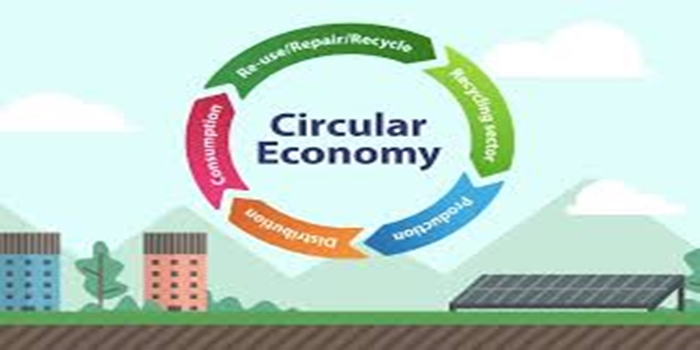In this article, we explained the meaning of circular economy, the example, the benefits, furthermore we stated the principles.
Definition
The circular economy is a growing movement that stresses resource efficiency, waste reduction, and regeneration of natural systems. It involves designing products for durability, recyclability, and reuse, keeping materials in use for as long as possible, and using renewable energy.
Examples of a Circular Economy Include:
Composting:
Transforming organic waste into a valuable fertilizer for agriculture, sports turf, and gardening is a prime example of a circular process.
Plastic Recycling:
Converting discarded plastics into new products is a well-known circular economy practice.
Recovering Agriculture:
Focusing on soil and ecosystem restoration is crucial for a circular economy, as it ensures the long-term health of natural resources.
Collaborative Economy:
Sharing resources instead of buying them, like through platforms that enable shared use of items, aligns with the circular economy’s principles.
Sustainable Fashion:
Practices in the fashion industry like designing durable clothing, encouraging reselling, and repairing and recycling clothing into new garments promote circularity.
Renewable Energy:
Utilizing renewable energy sources like solar and wind is essential for a circular economy as it reduces reliance on fossil fuels and minimizes environmental impact.
Reusable Packaging:
Reducing waste by using reusable packaging solutions is a key component of a circular economy.
Upcycling:
Transforming discarded materials into new, higher-value products is a form of circularity.
Functional Economy:
Focusing on providing services instead of products, like product-as-a-service models, can promote circularity by extending the life of products.
Eco-design:
Designing products with durability and recyclability in mind is a crucial element of the circular economy.
Closed-Loop Recycling:
Dell’s example of closed-loop recycling for electronics demonstrates how materials can be recovered and reused within a closed system.
Interface’s Carpet Manufacturing:
Interface’s approach to carpet manufacturing, which includes recycling and remanufacturing, is another example of a circular business model.
Teracycle’s Recycling:
Teracycle’s work in reimagining recycling for difficult-to-recycle materials showcases how circularity can be applied to various industries.
A Circular Economy offers significant Benefits, including:
Environmental Benefits:
Reduced Waste and Pollution:
Circular economy practices like recycling and upcycling minimize waste and pollution, lessening the need for resource extraction, which is often energy-intensive and harmful.
Decreased Greenhouse Gas Emissions:
By reusing and recycling materials, the circular economy reduces the need for new production, leading to lower greenhouse gas emissions.
Conservation of Natural Resources:
It promotes efficient use of resources like energy, water, and land, reducing strain on ecosystems and biodiversity loss.
Mitigating Climate Change:
By reducing emissions and pollution, the circular economy contributes to slowing down the effects of climate change.
Economic Benefits:
Resource Security:
The circular economy reduces dependence on virgin resources, mitigating risks associated with price fluctuations and supply shortages.
Cost Savings:
By optimizing resource use and reducing waste, companies can save costs on materials and energy.
Innovation and New Business Models:
The need to adapt to a circular economy drives innovation and the emergence of new business models and services.
Job Creation:
The circular economy can lead to job creation in industries related to recycling, repair, and resource recovery.
Increased Competitiveness:
By promoting resource efficiency and innovation, the circular economy can enhance the competitiveness of businesses.
Social Benefits:
Improved Climate Resilience:
The economy can help improve climate resilience by promoting sustainable practices and reducing reliance on fossil fuels.
Increased Productivity:
Resource efficiency and waste reduction can lead to increased productivity in various sectors.
Addressing Social Inequities:
The economy can address social inequities by creating more sustainable and equitable systems for resource management.
Other Benefits:
Enhanced Consumerism:
Consumers can benefit from longer-lasting products, repair services, and reduced waste, leading to more responsible consumption patterns.
Revaluation of Waste:
The circular economy enables the revaluation of materials once deemed waste, creating opportunities for new products and services.
Principles of the Circular Economy:
Design out waste and pollution:
This involves designing products and systems that minimize waste and pollution throughout their lifecycle.
Keep products and materials in use:
This focuses on extending the lifespan of products, promoting reuse, repair, and remanufacturing, and recycling materials back into the production cycle.
Regenerate natural systems:
This involves restoring and maintaining the health of natural ecosystems, such as through sustainable land management practices and biodiversity conservation.
Use renewable energy:
This emphasizes the transition to renewable energy sources to power the economy and reduce reliance on fossil fuels.
Conclusion
The circular economy offers a transformative approach to resource management and waste reduction, with the potential to create a more sustainable and resilient global economy. By embracing these principles, businesses and governments can contribute to a future where resources are used efficiently, waste is minimized, and the environment is protected.


